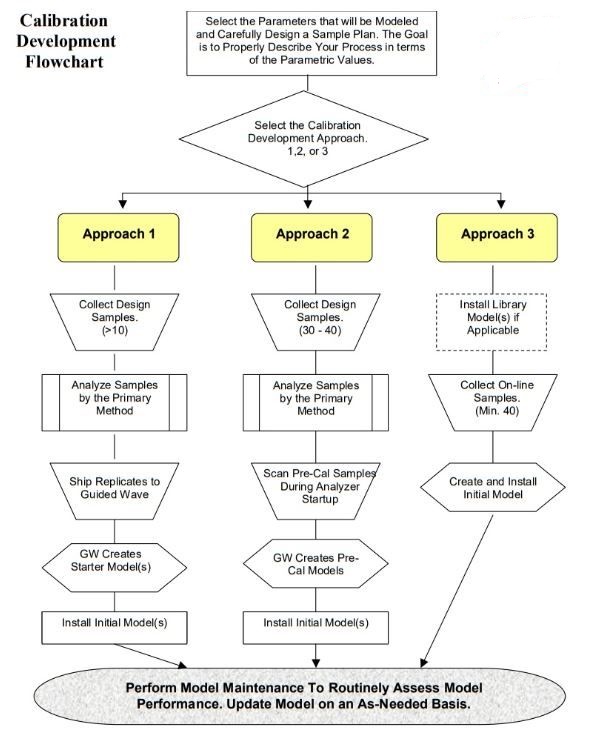Chemometric Calibration
Theory of Operation
Chemometric Calibration Development for Process Spectroscopy
Theory of Operations
For process spectroscopy to be successful an accurate chemometric model must be developed. The chemometric model translates the absorbance spectra collected by the process analyzer to real-world values such as Octane Number during fuel blending, or Acid Number and Diisocyanate ratios during polyurethane production.
Chemometric Approach 1
Prior to delivery of the analyzer, the Customer provides samples and matching laboratory results that are consistent with the target process stream. We are responsible for preparing Starter models that will provide ballpark values for each parameter for which results have been provided. Separate sample sets must be provided for each significantly different process stream. The data may be forwarded to us for model development if there is no on-site chemometrician
Chemometric Approach 2
Prior to delivery of the analyzer, the Customer collects line samples, analyzes them by the primary method(s) and then properly stores the samples. The stored samples will be scanned during analyzer commissioning. The scans and matching laboratory-obtained values are used in the development of Pre-Calibration models. The data may be forwarded to us for model development if there is no on-site chemometrician. Separate sample sets must be provided for each significantly different process stream.
Chemometric Approach 3
No sampling is required prior to delivery and subsequent installation and commissioning of the analyzer. Instead, the analyzer is started in training mode. Training mode is the period in which online samples are simultaneously scanned and collected for lab analysis in the actual analyzer system configuration. The time it will take to get enough training samples will vary from process to process. Where available, Library models may be deployed for interim results until the analyzer can be properly trained. Separate sample sets must be provided for each significantly different process stream.
Building a Starter Chemometric Calibration
The initial calibration is typically referred to as a starter model. The difficulty of building a successful calibration depends on the complexity of the process stream and the quality of the lab reference data. To ensure customer success, we have three recommended procedures for collecting, organizing, and analyzing the data to build a starter chemometric model.

Flowchart overview of the three recommended methods for collecting, organizing and analyzing the data to build a starter chemometric model
More Topics
- Why you should use NIR spectroscopy
- NIR Benefits for Online Process Measurements
- How does the Flow Rate, Viscosity, and Pipe Diameter, Effect Accurate (good) NIR Measurements?
- What is pathlength and why is it important when selecting a sample interface?
- Double down on double beam
- Why NIR is better than GC
- Difference between FT-NIR and dispersive dual-beam (DG-NIR) process analyzers
- Benefits of FT-NIR for online process management
- How safety standards in explosive or incendive processes apply to our probes and flow cells
- What is Diffraction Grating?
- Chemometric Calibration Development
- Model Maintenance and Customizing a Starter Model to Meet Your Operational Needs